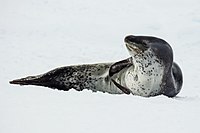
Photo from wikipedia
Foraging behavior underpins many ecological processes; however, robust assessments of this behavior for free-ranging animals are rare due to limitations to direct observations. We leveraged acoustic monitoring and GPS tracking… Click to show full abstract
Foraging behavior underpins many ecological processes; however, robust assessments of this behavior for free-ranging animals are rare due to limitations to direct observations. We leveraged acoustic monitoring and GPS tracking to assess the factors influencing foraging behavior of mule deer (Odocoileus hemionus). We deployed custom-built acoustic collars with GPS radiocollars on mule deer to measure location-specific foraging. We quantified individual bites and steps taken by deer, and quantified two metrics of foraging behavior: the number of bites taken per step and the number of bites taken per unit time, which relate to foraging intensity and efficiency. We fit statistical models to these metrics to examine the individual, environmental, and anthropogenic factors influencing foraging. Deer in poorer body condition took more bites per step and per minute and foraged for longer irrespective of landscape properties. Other patterns varied seasonally with major changes in deer condition. In December, when deer were in better condition, they took fewer bites per step and more bites per minute. Deer also foraged more intensely and efficiently in areas of greater forage availability and greater movement costs. During March, when deer were in poorer condition, foraging was not influenced by landscape features. Anthropogenic factors weakly structured foraging behavior in December with no relationship in March. Most research on animal foraging is interpreted under the framework of optimal foraging theory. Departures from predictions developed under this framework provide insight to unrecognized factors influencing the evolution of foraging. Our results only conformed to our predictions when deer were in better condition and ecological conditions were declining, suggesting foraging strategies were state-dependent. These results advance our understanding of foraging patterns in wild animals and highlight novel observational approaches for studying animal behavior.
Journal Title: Journal of Mammalogy
Year Published: 2019
Link to full text (if available)
Share on Social Media: Sign Up to like & get
recommendations!